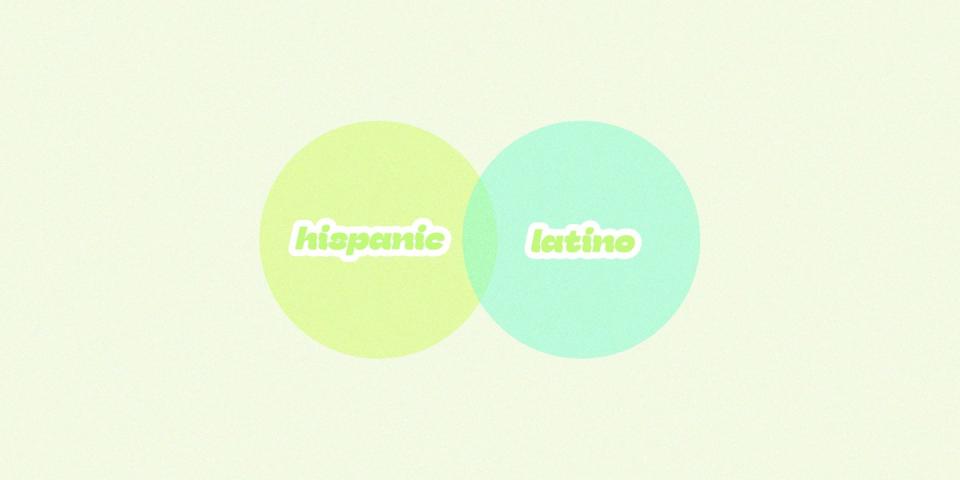What is the Difference Between Hispanic vs. Latino?

Hispanic Heritage Month is officially upon us, which means there are more conversations about Hispanic and Latinx people happening every day. Whether you're looking to dive into the culture headfirst by watching Hispanic movies or want to shop from and support Latinx-owned brands, understanding the history and context behind Hispanic Heritage Month is essential for any celebration.
The terms "Hispanic" and "Latino" (or "Latinx") have been used interchangeably for decades, but you might not know that they actually have different meanings. While there's a lot of overlap between the two terms, there's one key factor that differentiates being Hispanic from being Latino.
We tapped Dr. Maria Raquel Casas, Associate Professor of History at the University of Nevada Las Vegas (UNLV), to find out what the Hispanic vs. Latino meaning really is and how each term came to be.
What does it mean to be Hispanic?
"A Hispanic is a person who the government usually characterizes as being of Iberian, Latin American, or Caribbean descent," Dr. Casas says. Per History, "Hispanic" and "Latino" were first used by the federal government in the 1980 Census to group immigrants and their ancestors who come from Spanish-speaking areas.
If someone is Hispanic, that means they either speak Spanish or come from one of the following areas:
Argentina
Bolivia
Chile
Colombia
Costa Rica
Cuba
Dominican Republic
Ecuador
El Salvador
Guatemala
Honduras
Mexico
Nicaragua
Panama
Paraguay
Peru
Puerto Rico
Spain
Uruguay
Venezuela
The term "Hispanic" was first used by the federal government after decades of constant lobbying for representation.
What does it mean to be Latino/Latina/Latinx?
If someone is Latinx, they are from Latin America or have ancestors that hailed from the following areas:
Argentina
Bolivia
Brazil
Chile
Colombia
Costa Rica
Cuba
Dominican Republic
Ecuador
El Salvador
French Guiana
Guadeloupe
Guatemala
Haiti
Honduras
Martinique
Mexico
Nicaragua
Panama
Paraguay
Peru
Puerto Rico
Saint Barthélemy
Saint Martin
Uruguay
Venezuela
The term "Latino" is a shortened version of the Spanish term Latinoamericano, and according to a 2020 report by the Pew Research Center, only 3% of Latinos in the United States use the gender-neutral term "Latinx."
What is the history behind the terms "Hispanic" and "Latino"?
In case you were looking for a crash course in the history behind the terms "Hispanic" and "Latino," we've got you covered. According to Dr. Casas, the history of each term is extensive and dates all the way back to 1492, when Spain encountered the New World and tried to bring their religion and language to unknown territories. In more recent history, though, "Hispanic" and "Latino" came to be during President Richard Nixon's administration in the '60s.

"In the 1960s, the Republican party was in power and they wanted to reach out to the growing Latino populations but didn't know what term to use. 'Mexican' and 'Chicano' were thought of as offensive and low class [terms]," Dr. Casas says, explaining that "Latino" was also a questionable term at the time. President Nixon's administration came up with the non-offensive alternative, "Hispanic."
"It was generic enough to incorporate the Latin American and Caribbean populations, so Hispanic is a governmental term which is why most people prefer Latinos, but some people have accepted Hispanic," Dr. Casas tells Seventeen.
What is the difference between Hispanic vs. Latino?
Believe it or not, the difference between these terms all comes down to history and geography. Both categories are ethnicities that only reference a person's origin and ancestry, which means a Latinx or Hispanic person can be of any race, regardless of the country they come from.

According to Dr. Casas, people often use the term interchangeably because they have been used and referred to since the 1970s. "As each term incorporates so many ethnic groups, [people] don't see [it as a significant difference], but some people are invested in one term over the other," she says.
As mentioned earlier, Hispanic people are from Spanish-speaking Latin America, as well as the Caribbean and Spain. The term "Hispanic" includes Spain, but does not include:
Brazil
French Guiana
Guadeloupe
Martinique
Haiti
Saint Barthélemy
Saint Martin
On the other hand, Latinos hail from Latin America or have ancestors that do. The term includes Brazil and the countries listed above but does not include Spain.
However, both groups do include the following countries, which means anyone who hails from there is both Hispanic and Latino:
Argentina
Bolivia
Chile
Colombia
Costa Rica
Cuba
Dominican Republic
Ecuador
El Salvador
Guatemala
Honduras
Mexico
Nicaragua
Panama
Paraguay
Peru
Puerto Rico
Uruguay
Venezuela
Given this information, a Brazilian could be Latino and non-Hispanic while a Spaniard could be Hispanic and non-Latino. In the case of someone from Cuba, for example, they are both and can truthfully use both terms interchangeably.
You Might Also Like

